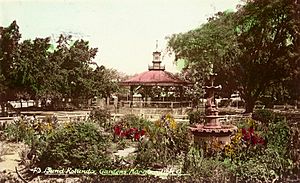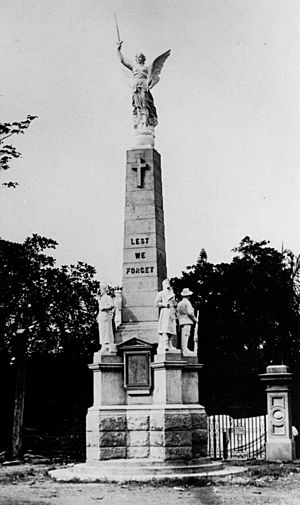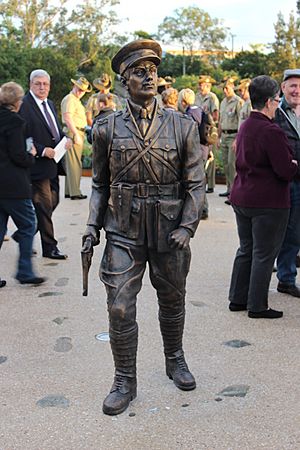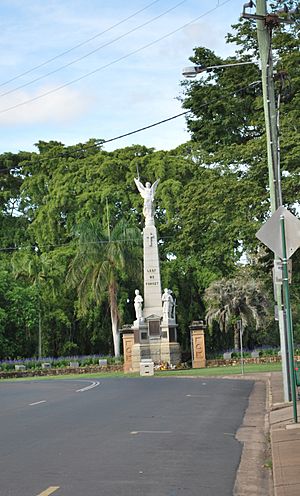Queen's Park, Maryborough facts for kids
Quick facts for kids Queen's Park, Maryborough |
|
|---|---|
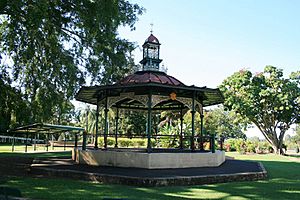
Band rotunda in Queen's Park, 2009
|
|
| Location | Sussex Street, Maryborough, Fraser Coast Region, Queensland, Australia |
| Design period | 1870s - 1890s (late 19th century) |
| Built | c. 1873 - c. 1990 |
| Official name: Queen's Park, War Memorial and Entrance Gates; Bandstand; Banyan Fig; Bunya Pine; Crows Ash; Sausage Tree | |
| Type | state heritage (built, landscape) |
| Designated | 21 October 1992 |
| Reference no. | 600708 |
| Significant period | 1890-1922 (fabric) 1873-ongoing (social) |
| Significant components | pathway/walkway, memorial - fountain, fernery, lake / pond / waterway, memorial - obelisk, bandstand/rotunda, trees/plantings, tree groups - avenue of, memorial - gate/s, memorial - soldier statue |
| Lua error in Module:Location_map at line 420: attempt to index field 'wikibase' (a nil value). | |
Queen's Park is a special historic park in Maryborough, Australia. It's a beautiful botanic garden located on Sussex Street. The park was officially set aside for botanical gardens in October 1873. It is also home to the Maryborough War Memorial. Because of its importance, Queen's Park was added to the Queensland Heritage Register on 21 October 1992.
The History of Queen's Park
Since it was first made a park in 1873, Queen's Park has changed over time. It has been used for different things and has seen many new features added.
How Maryborough Grew
In 1842, explorer Andrew Petrie found the Monaboola stream, which later became the Mary River. The town of Maryborough grew up around this river. In 1847, Surveyor James Charles Burnett explored the area. Governor Charles Augustus FitzRoy later renamed the river the Mary River, after his wife.
By 1850, Surveyor Hugh Roland Labatt arrived to find the best place for a town. The spot he chose is where Maryborough stands today. In 1852, the first land was sold at this new site. The older settlement on the north side of the river was left behind. This was because bigger ships could not reach its wharves.
The 1850s and 1860s were a time of fast growth for Maryborough. A hospital was started by 1859, and a courthouse was built in 1857. The School of Arts opened in 1861. Maryborough became an official port of entry when Queensland separated from New South Wales in 1859. In 1861, Maryborough became a municipality, and Henry Palmer became its first Mayor.
In 1865, Mayor Palmer suggested that the council ask the government for land. He wanted the land near the wharf to be used as a public garden and for fun activities.
Early Plants and Trees
In the mid-1840s, a plant expert named John Carne Bidwill collected tree samples. He found a tree known as Bunya Bunya to local Indigenous people. This tree was later sent to Kew Gardens in London. There, it was identified as a new type of Araucaria. It was named Araucaria bidwillii to honor Bidwill's work.
The Botanic Gardens Begin
In 1854, Sir Charles Moore and Brisbane Botanic Gardens Curator Walter Hill collected plants from Bidwill's garden. The Bunya Pine in Queen's Park is thought to be one of these original trees. A Sausage Tree (Kigelia pinnata) in the park is also believed to be from Bidwill's collection.
By the late 1860s, the Brisbane Botanic Gardens were very well known. Walter Hill showed off their work at an exhibition in Sydney in 1867. This made people more aware of how useful gardens could be. Hill then worked to create more botanic gardens across Queensland. Parks in Toowoomba and Ipswich were already set up.
Public parks became popular in the 1800s. They gave people a place to relax outdoors, especially those without private gardens. Botanic Gardens started because of a growing interest in science. They helped people understand plants and nature better. The Brisbane Botanic Gardens, started in 1855, had smaller "branch gardens" in other towns like Maryborough. These helped collect plant information from all over Queensland.
Before it was a park, the Queen's Park site had a factory that processed animal products. After it was made a Reserve for Botanical Gardens in October 1873, a group of Trustees was chosen. These included Henry Palmer and Richard Bingham Sheridan. Sheridan was a public servant who became very involved in Maryborough. He helped start the Botanic Gardens, the School of Arts, and the hospital.
In 1876, Sheridan reported on the Botanic Gardens. He said the park was doing very well. The land was about 70 acres (28 hectares). About 58 acres (23 hectares) was a "Recreation Reserve" with a fence and some plants. The other 12 acres (5 hectares) was the "Botanic Gardens." This part was in the town and along the river, making it a favorite spot for people. It was planted with many beautiful and useful trees, shrubs, and flowers. By 1876, the gardens also had a decorative bridge and a gardener's cottage.
The report also said that the gardens helped spread a love for floriculture (growing flowers) in the area. They gave plants and seeds to people and even sugar cane cuttings to farmers. They also started a nursery for fruit trees and vegetables. Early photos from around 1862 show the crows ash (Flindersia australis) tree. Other photos from 1905 show the banyan fig (Ficus benghalensis). This type of fig is rare in Australia and has roots that grow into many trunks.
The Melville Fountain and Bandstand
In 1890, the Melville or Fairy Fountain was revealed. It was placed under a rotunda, which is a round building with a dome. Miss Janet Melville left money for this fountain and a bandstand. She wanted to honor her brother, Andrew Wedderburn Melville.
The fountain was chosen from an exhibition in Glasgow, Scotland, in 1888. It arrived in Maryborough in December 1889. The rotunda was also imported from Scotland. It came from a company called William MacFarlane & Co.
At first, the bandstand was on the ground, making it hard to see the musicians. Later, it was moved 18 meters (59 feet) and placed on a concrete base. The fountain was also moved at some point so the rotunda could be used just for bands. Janet Melville was a very generous person in Maryborough. She gave a lot of money to local places like the hospital.
A newspaper report from the time described the fountain: "From the center of a large basin rises a column with griffin heads... On the top of the column are three cranes... and in the center... is a golden cherub clasping a horn of plenty from which a jet of water is thrown upwards..."
The Maryborough War Memorial
The Maryborough War Memorial was officially opened on 19 November 1922. Major General Reginald Spencer Browne unveiled it. Philip Oliver Ellard Hawkes designed the memorial, and a local company, Frederick William Webb, built it. This memorial, made of granite and marble, honors the 100 local men who died in World War I and the 55 who died in World War II.
The memorial originally had two sets of gates, but one pair was later removed. The main gates are made from British gun metal and were cast by the local Croydon Foundry.
In May 1920, a committee was formed to raise money for a war memorial. The first stone was laid on 22 May 1921. However, it took almost 18 months to raise enough money, and the memorial was finally unveiled later.
Philip Oliver Ellard Hawkes was an architect who worked in many Australian cities. He designed the Maryborough memorial and chose its location. The bronze parts of the monument and gates were made by Stevenson Brothers at Maryborough's Croydon foundry. At a cost of £2,300, it was one of the most expensive memorials in Queensland at the time.
Before World War I, Australia had few public monuments. The memorials built after the war became important national symbols. They showed the huge impact the war had on the country. Australia lost 60,000 soldiers from a population of about 4 million. This was a massive loss for a young nation.
These memorials were like sacred grave sites for soldiers whose bodies were buried overseas. The word "cenotaph" means "empty tomb." Australian war memorials are special because they honor all who served, not just those who died. This shows how much communities were involved in the war.
The Maryborough monument has four statues and a winged figure of victory. These statues were imported from Italy. They include a soldier, a sailor, an airman, and a Red Cross nurse. Later, tablets were added to remember those who died in World War II and other wars.
Since the mid-1990s, the Maryborough City Council has worked to restore Queen's Park. They have brought back the Cocos Palm Avenue, the rose trellis, maze gardens, the Melville Fountain, and the Judges' Walk. The pathway from Bazaar Street to Wharf Street is called Judges' Walk. This is because judges used to walk along it in their robes to the courthouse, with an escort.
Duncan Chapman Statue
On 24 April 2015, a life-sized bronze statue of Lieutenant Duncan Chapman was unveiled. This was part of the 100-year anniversary of the Gallipoli landing in World War I. Chapman was the first soldier to step ashore at Gallipoli on 25 April 1915. He was born in Maryborough in 1888 and went to Maryborough Grammar School. He died in battle on 6 August 1916 in France.
What You Can See in Queen's Park
The War Memorial
The First World War Memorial stands proudly at the entrance to the Botanic Gardens. It has a low rock wall garden around it. Behind the memorial are large white wrought iron gates with special lettering and the Australian Imperial Force (AIF) badge. These gates are next to stone pillars. The memorial is 45 feet (13.7 meters) tall to the top of its obelisk. It has a base, four statues, and the obelisk topped with a Winged Victory statue.
The gray granite monument sits on two round concrete steps. The base is made of three layers of granite. Bronze plaques on the base list the names of the 100 local people who died in World War I. There are also plaques for the 55 soldiers who died in World War II.
At each end of the cross-shaped base stands a life-sized marble statue. These statues face outwards and represent a Red Cross nurse, a soldier, a sailor, and an airman. They look very Italian in their style.
In the center of the four statues is a tall obelisk. It has bronze wreaths and Latin crosses on its sides. The words "LEST WE FORGET" are also in bronze letters. On top of the obelisk is a larger-than-life Winged Victory figure made of marble.
Next to the memorial are dedication tablets that say: "Maryborough's Grateful Tribute to HER GALLANT SONS, Who fell in the Great War, 1914-1918. The bravest thing God ever made, Our deathless dead not once dismayed. Theirs the greater love - Ours the debt unpaid."
Park Entrance Gates
The main entrance gates are behind the War Memorial. They are large, white, wrought iron swing gates. They have special words and the AIF badge on them. Stone pillars stand on either side of the gates. There used to be two sets of gates, but the outer pair was removed.
The Bandstand and Melville Fountain
The Bandstand is a decorative building in Queen's Park. It was first built as a cover for the Melville Memorial Fountain. The bandstand has a curved roof supported by cast iron columns on a concrete base. The Melville Fountain is near the park's south-eastern corner. It is made of cast iron. Water spouts from griffin heads around the top of a central column. On top of the column are three cranes. From the center, two flower-shaped tiers rise. In the middle of the top tier, a cherub holds a horn of plenty from which water shoots upwards.
The Fernery
The Fernery is a single-story building with two domes. It is made of concrete blocks and has green shade covers over a metal frame. It is a noticeable landmark at the end of Adelaide Street, where it meets Sussex Street.
The Lily Pond
The Lily Pond is located in the north-western part of Queen's Park. It's a peaceful spot with water lilies.
Gardens and Trees
Queen's Park has many large, old trees. There is a line of Cocos Palm Avenue (Queen palms - Syagrus romanzoffiana) running through the park from north to south. Other trees include banyan figs (Ficus benghalensis), poinciana trees (Delonix regia), celtis (Celtis sinensis), and weeping figs (Ficus benjamina). These trees run from north-west to south-east. You can also see the banyan fig, crows ash (Flindersia australis), sausage tree (Kigelia pinnata), and bunya pine (Araucaria bidwillii) in the south-east corner near the entrance.
The park has many pathways and seating areas for visitors to enjoy.
Why Queen's Park is Special
Queen's Park was added to the Queensland Heritage Register on 21 October 1992. This means it is a very important place for several reasons:
It Shows Queensland's History The network of botanic gardens in Queensland, including Queen's Park, helped bring new plants to the area. These gardens were important for science, education, and fun. Queen's Park, started in 1873, was a main recreation and plant center for the Maryborough area. It shows how important Maryborough was as a big regional town.
The Bandstand, built in 1890, shows how Maryborough grew in the late 1800s. War Memorials like the one in Queen's Park show a common part of Queensland's history. They prove how much people loved their country during and after World War I. These monuments also show the popular styles of the time.
It Shows What a Botanic Garden Should Be Like Queen's Park shows what a regional botanic reserve should be. It has a mix of plants from other countries and native plants. Some plants are very old or rare. The plants from the 1800s show how people used plants for beauty, money, and experiments.
The bandstand is a rare example of an imported cast iron building from Scotland. It shows what 19th-century bandstands looked like. The War Memorial, unveiled in 1922, is a good example of a structure built to remember a big historical event. It uses suitable materials and design.
It is Beautiful Queen's Park has many beautiful features. These include the Bandstand and Memorial Fountain (1890), the War Memorial and Memorial Gates (1922), and the dome-shaped Fernery. The Lily Pond and the rows of trees, like banyan figs and palm trees, are also very pretty. The old banyan fig, crows ash, sausage tree, and bunya pine trees in the south-east corner are especially lovely. The bandstand adds to the park's charm.
The War Memorial is also very beautiful and one of the most detailed monuments in Queensland. It's unusual because its statues look more Italian than Australian. As a large regional memorial, it is a major landmark in the town.
It is Important to the Community Queen's Park was the first park created by the Maryborough City Council. It shows their dedication to providing fun and learning places for the people. Many important events have happened in the gardens. People in the community love the park, and visitors enjoy it too. It is a well-known landmark in Maryborough.
The park has been used for public fun for a long time. It also shows how the state government gave local councils control over public parks. The park has many memorials that remember important local people, like Richard Bingham Sheridan. The War Memorial is strongly linked to the community because it shows the impact of a big historical event. It also shows the work of Maryborough architect P.O.E. Hawkes and local builders F.W. Webb.
It is Linked to Important People Queen's Park is important because of its connection to the work of Richard Bingham Sheridan and Henry Palmer, Maryborough's first Mayor. It is also linked to Walter Hill, who helped set up many botanic gardens in Queensland. His knowledge was very important for starting these scientific gardens. The bandstand is connected to Miss Janet Melville and her brother, Andrew Wedderburn Melville, who were important Maryborough citizens.


